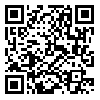Volume 16, Issue 10 (1-2017)
Modares Mechanical Engineering 2017, 16(10): 77-84 |
Back to browse issues page
Download citation:
BibTeX | RIS | EndNote | Medlars | ProCite | Reference Manager | RefWorks
Send citation to:



BibTeX | RIS | EndNote | Medlars | ProCite | Reference Manager | RefWorks
Send citation to:
Shankayi M, Nategh M J. Stability Analysis of the Vibration Assisted Turning Process. Modares Mechanical Engineering 2017; 16 (10) :77-84
URL: http://mme.modares.ac.ir/article-15-3391-en.html
URL: http://mme.modares.ac.ir/article-15-3391-en.html
1- Assoc. Prof, Mechanical Engineering Department, Faculty of Engineering, Tarbiat Modares University
Abstract: (4292 Views)
Chattering, being the focus of this study is a kind of self-excited vibration that is encountered in different machining processes such as milling and turning. This type of self-excited vibration rapidly develops after commencement and destabilizes the whole process. This phenomenon leads to, among others, increased noise, wavy surface finishes, discontinuous chips, and failure in the tool or machine parts. The depth of cut is the main parameter in the occurrence of chattering in machining processes. Avoiding the critical depth of cut ensures the stability of the process. Process modeling is a way to obtain the critical depth of cut. The vibration assisted turning process, having many advantages, is of a different nature than the conventional machining. In this paper, the vibration assisted turning process is modeled and numerically solved and the critical depth of cut is obtained. Validation of the results is performed using experimental data and comparison with conventional machining. In the vibration assisted turning process, higher stability is obtained with lower ratios of cutting duration to the total vibration period. This ratio is directly proportional to vibration frequency and amplitude and is inversely proportional to the cutting speed.
Article Type: Research Article |
Subject:
Manufacturing Methods
Received: 2016/07/20 | Accepted: 2016/08/21 | Published: 2016/10/2
Received: 2016/07/20 | Accepted: 2016/08/21 | Published: 2016/10/2
| Rights and permissions | |
 |
This work is licensed under a Creative Commons Attribution-NonCommercial 4.0 International License. |







